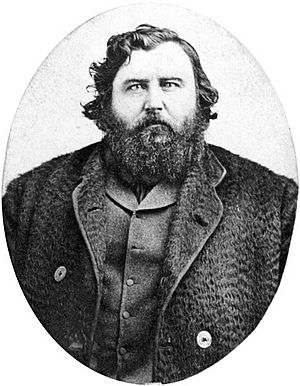James McKay (fur trader) facts for kids
Quick facts for kids
James McKay
|
|
|---|---|

James McKay in the 1870s
|
|
| Born | 1828 Fort Edmonton, current-day Alberta
|
| Died | December 2, 1879 |
| Employer | Hudson's Bay Company |
| Relatives | Angus McKay (brother) |
James McKay (1828 – December 2, 1879) was an important person in early Canadian history. He was a fur trader, a pioneer, and a politician before Canada became a country. He also worked as an interpreter, helping people from different backgrounds understand each other.
Contents
Early Life and Work
James McKay was born in 1828 at Fort Edmonton. This was a trading post of the Hudson's Bay Company in what is now Alberta. His father was James Charles McKay and his mother was Marguerite Gladu, who was Métis. He was the brother of Angus McKay.
James McKay went to school at the Red River Colony. This was an early settlement in what is now Manitoba. In 1853, he started working for the Hudson's Bay Company. He was a fur trader, a guide, and an interpreter. Many important visitors asked him to be their guide. He often guided George Simpson, who was the governor of the Hudson's Bay Company. In 1857, he guided the John Palliser party. This group was exploring the Canadian prairies.
McKay got married in 1859. He left the Hudson's Bay Company in 1860 to start his own business. He built his home near the Forks in present-day Manitoba. He quickly became involved in his community. In 1868, he became a member of the Council of Assiniboia. This was a local government.
Between 1869 and 1870, there was conflict in the Red River Colony. Because James McKay was Métis, he decided to leave for a short time. When he came back, he joined the provisional government. His brother, Angus McKay, was also very active in the politics of that time.
Political Contributions
James McKay made many important contributions to the new Canadian government. He helped deal with land agreements and represented the Métis people.
Helping with Treaties
McKay played a big role in settling land claims with Indigenous peoples. These agreements are called Treaties. In 1871, he helped negotiate Treaty 1 and Treaty 2. He continued this work with Treaty 3 in 1873. In 1875, he was a commissioner for Treaty 5. He was also the Indian commissioner for Treaty 6 in 1876. His skills as a negotiator and interpreter were very important for these agreements.
Serving on Councils
In 1873, James McKay was appointed to the Temporary North-West Council. This was a government council for the Northwest Territories. He was appointed along with Pierre Delorme and Joseph Royal. These appointments happened because the Métis people wanted to have a say in the government. While on the council, McKay worked on issues affecting Indigenous people.
Manitoba's Government
After Manitoba became a province, McKay was appointed to the Legislative Council of Manitoba. He served as its speaker until 1874. The Legislative Council was later ended in 1876. After that, he was elected to the Legislative Assembly of Manitoba. He represented the district of Lake Manitoba.
From 1875 to 1878, McKay served as the Minister of Agriculture. He resigned from this role because of poor health. People thought he had excellent judgment. He was also strongly influenced by the views of Archbishop Alexandre-Antonin Taché.

